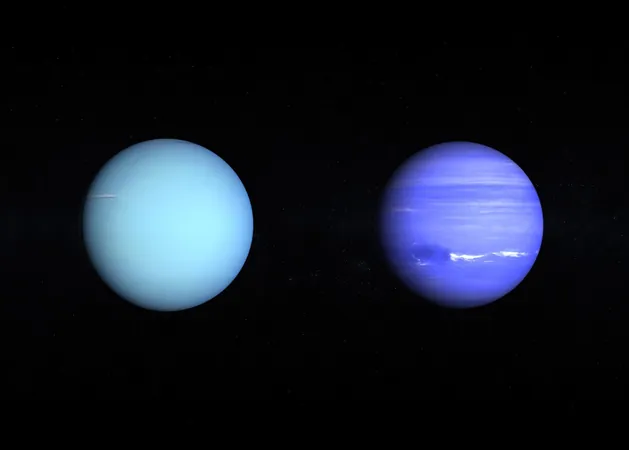
Groundbreaking Theory: Uranus and Neptune Home to Ocean Layers 5,000 Miles Deep!
2025-03-22
Author: Siti
Groundbreaking Theory: Uranus and Neptune Home to Ocean Layers 5,000 Miles Deep!
The enigmatic interiors of Uranus and Neptune, the outer ice giants of our solar system, have long fascinated researchers trying to decipher their formation and evolution. Scientists have explored various tantalizing hypotheses, from the idea of diamond rains cascading through their cores to unusual states of water beneath their striking blue atmospheres.
Yet, questions linger about the peculiar nature of these planets' magnetic fields and internal structures. A new theory, crafted through years of meticulous study and sophisticated computer simulations, offers a fresh perspective that could revolutionize our understanding of these distant worlds.
Professor Burkhard Militzer from the University of California, Berkeley, has developed a model that challenges conventional wisdom about Uranus and Neptune. This innovative theory hinges on the concept of immiscibility—the tendency of certain materials to remain separate, akin to oil not mixing with water.
Revolutionary Insights: Layered Interiors and Unique Magnetic Fields
Militzer’s research posits that under the extreme pressures found in the depths of these planets, essential elements like water (H₂O), methane (CH₄), and ammonia (NH₃) do not behave as one might expect. Instead, these substances separate into distinct layers, with lighter hydrogen-dominant zones rising to the top while denser materials settle below.
“We now have, I would say, a good theory about why Uranus and Neptune have really different magnetic fields, which starkly contrast with those of Earth, Jupiter, and Saturn,” Militzer elaborated. His findings align remarkably well with magnetic field data acquired by NASA's Voyager 2 during its 1980s flyby, revealing the chaotic nature of these giants’ magnetic environments.
Militzer theorizes that the water-rich layer beneath the atmospheres can flow and interact in ways that create these irregular magnetic fields, while a stable hydrocarbon-dominant layer deep below remains unperturbed.
The Power of Advanced Simulations
Delving deeper, Militzer utilized advanced computational models to replicate the conditions found at depths of up to 3.4 million times Earth's atmospheric pressure, coupled with scorching temperatures of approximately 8,000°F. Over the last decade, his research transitioned from simulations involving merely 100 atoms to more recent models using 540 atoms, benefitting from machine learning techniques and enhanced computing power.
“Just one day, I noticed that the water had separated from the carbon and nitrogen,” he recounted. The outcome of these simulations revealed a theoretical structure: beneath Uranus’s 3,000-mile-thick atmosphere lies an astonishing 5,000-mile-thick ocean of water-rich fluid, topped by a similarly extensive hydrocarbon layer and culminating in a rocky core comparable to Mercury’s size. Neptune displays a similar build, though with a thinner atmosphere and a marginally larger core akin to that of Mars.
Why This Matters for Science and Beyond
The implications of this research extend far beyond the confines of our solar system. Ice giants similar to Uranus and Neptune appear to be widespread in the universe, often dubbed 'sub-Neptune' exoplanets. Militzer’s model suggests that if other star systems share similar compositions, their ice giants may possess parallel internal structures.
This innovative theory not only enlightens our understanding of Uranus and Neptune but also challenges the romantic notion of diamond rain and exotic super-ionic water. Instead, Militzer asserts that the separation into distinct layers provides a more plausible explanation for the magnetic anomalies observed.
As space exploration continues to advance, upcoming missions could further illuminate these theories. For instance, a proposed NASA expedition to Uranus may include equipment designed to measure the planet’s vibrational patterns through Doppler imaging. Militzer intends to utilize his models to predict how these vibrations will manifest, offering another avenue for validation of his groundbreaking layered theory.
The Journey Ahead: Unraveling Planetary Mysteries
Militzer's revolutionary perspective adds exciting depth to humanity's centuries-long quest to understand the makeup of our solar system. Each new discovery builds upon a foundation of observations—from telescopic data to spacecraft recordings, now enhanced by sophisticated simulations.
His findings pave the way for a comprehensive approach to unraveling the mysteries surrounding Uranus and Neptune’s interiors and magnetic properties. By identifying two distinct immiscible layers—one rich in water and the other in highly compressed hydrocarbons—this theory represents a significant stride toward unraveling the secrets of these enigmatic giants, one simulation at a time.
This remarkable study has been documented in the esteemed journal *Proceedings of the National Academy of Sciences*, opening new dialogues within the scientific community.
Stay tuned for more staggering revelations about our universe—who knows what adventures lie ahead!




 Brasil (PT)
Brasil (PT)
 Canada (EN)
Canada (EN)
 Chile (ES)
Chile (ES)
 Česko (CS)
Česko (CS)
 대한민국 (KO)
대한민국 (KO)
 España (ES)
España (ES)
 France (FR)
France (FR)
 Hong Kong (EN)
Hong Kong (EN)
 Italia (IT)
Italia (IT)
 日本 (JA)
日本 (JA)
 Magyarország (HU)
Magyarország (HU)
 Norge (NO)
Norge (NO)
 Polska (PL)
Polska (PL)
 Schweiz (DE)
Schweiz (DE)
 Singapore (EN)
Singapore (EN)
 Sverige (SV)
Sverige (SV)
 Suomi (FI)
Suomi (FI)
 Türkiye (TR)
Türkiye (TR)
 الإمارات العربية المتحدة (AR)
الإمارات العربية المتحدة (AR)